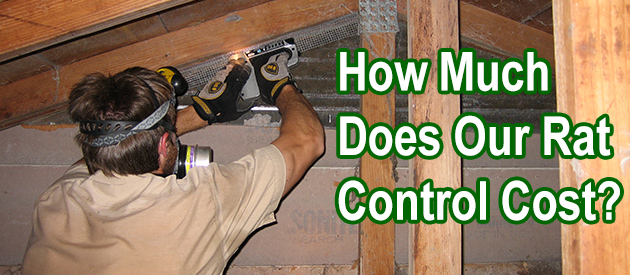Madison County, Huntsville Rat Control Situation:
Hi David, I found your website online -- very informative for removing rats and squirrels from attics. My problem is the animal(s), which I'm guessing are rats or mice because they only scratch at night, is in the ceiling, but there is no attic or crawl space. The structure is a two story condo and the scratching sound is in the same location for the past 2 - 3 nights: in the ceiling of the small landing between the two upstairs bedrooms. There is a recessed light in that ceiling, and removing the light cover does provide a small access into the ceiling. The actual hole is about 6 - 7" wide, but there is an old-style light can in the hole, which only has a few small openings in it. Last year prior to painting the ceiling we removed the light cover and down came some animal droppings. Even though we weren't hearing any animal noises at that time, we set two Victor mouse traps which we were able to fit inside the small openings. We didn't catch anything so eventually, we just put the light cover back on. Now, there is very active scratching in the ceiling a few inches from the light so there is definately something alive in there. If it's a mouse, we can probably set a trap like we did before and I believe there is enough of an opening to remove the trap with a mouse in it. If it's a larger critter like a rat, we may or may not be able to set the larger trap and/or remove the trap with the dead animal because the opening may be too small. Even if we are successful at trapping and removing the animal, there is little access to remove the droppings or see if they've done any damage in there. Any suggestions you have would be greatly appreciated. Thanks. Nicole in Huntsville AL
Between floors is hard. If you can get a trap inside, great. You still need to Inspect the house and find out how the rodents are getting inside and seal up every single last entry/exit hole and gap with steel.
Huntsville Rat Control Tip of The Week
Will A Rat And Her Babies Nest In An Attic?
If you have a possible rat infestation in your home, chances are that rats and her babies are nesting in your attic. These rodents have a special liking for dark places with small holes where they can reproduce and there is no better place to do that in your home than your attic.
Unlike other parts of every home, attics are places with little to no source of food. So you might be wondering why they would go all the way there just to stay. Once the rats in your home decide to move into your attic, their primary objective is to go and give birth to their babies. With their short gestation period of just 22 to 28 days, you will be having an average of 10 babies from just a single mother. This shows how rapid rats can breed in your attic when allowed to.
Having realized this, you need to get rid of the rats in your attic whenever you seek out to remove other animals nesting there too. Apart from breeding in your attic, rats are very destructive. Within just a short time, they can wreak havoc in your attic by creating cavities in and around your attic.
To remove the rats and her babies nesting in your attic, all you have to do is search your attic carefully. Although, this can be a very difficult task because rats are good at creating hideouts when they want to nest. As a result of this, you might need to consider other removal methods such as the use of lethal traps, rat poisons, and sticky traps which are often inhumane methods.
If you are not too comfortable with the use of these methods, the best thing you can do is hire a wildlife removal expert to help you get rid of the rat and her nest of babies.


